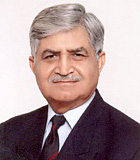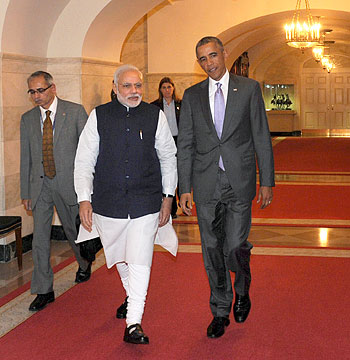INDIAN ARMED FORCES CHIEFS ON
OUR RELENTLESS AND FOCUSED PUBLISHING EFFORTS

SP Guide Publications puts forth a well compiled articulation of issues, pursuits and accomplishments of the Indian Army, over the years

I am confident that SP Guide Publications would continue to inform, inspire and influence.

My compliments to SP Guide Publications for informative and credible reportage on contemporary aerospace issues over the past six decades.
- Prime Minister witnesses 'Bharat Shakti' – a Tri-Services Firing and Manoeuvre Exercise in Pokhran, Rajasthan
- Interim Defence Budget 2024-25 — An Analysis
- Union Defence budget 2024
- Prime Minister Modi Commemorates Indian Navy Day in a Grand Ceremony
- Prime Minister Modi Flies in the LCA Tejas
- New Chapter in India-Italy Defence Ties
- Airpower beyond Boundaries
Prime Minister Modi in USA
 |
By General V.P. Malik (Retd) Former Chief of the Army Staff |
Never before have there been such media hype, and millions’ expectations and hopes, when an Indian Prime Minister has visited the USA. Let me note the major takeaways from Prime Minister Narendra Modi’s roller coaster visit before going into the substantive issues that were discussed in Washington DC.
The first and foremost is the Modi persona. To the global leaders watching him, he came across as a confident, self-assured political statesman, steeped in the Indian values, who had a vision of India, its region, and the world at large: someone who would need to be watched in future. To the young, he was a rock-star; friendly, energetic and down to earth, who showed no signs of a generation gap. To most Americans, he came across as a charismatic leader and to some as an enigma. How could he speak to and connect so well with his audience? Can he deliver what he promised so emphatically?


Modi’s most captivating image was on the rotating platform in the middle of the Madison Square Garden. His extempore speech in Hindi, in which he is incomparable, was lapped up by the Indian diaspora, which is amongst the wealthiest, best educated and influential in the USA. His audience wore ‘I love my India’ on the sleeve and cheered every sentence that he spoke.
Modi, deprived of a US visa for 10 years, told the rapturous crowd that ‘Persons of Indian Origin’ Card Holders would get life long visas. Non Resident Indians, staying for long in India, would not have to visit the police station for reporting/registration. By the time the Madison Square Garden spectacle ended, he had become an icon; someone who would enable them to remember and talk about their ethnic roots with pride. With his walk and talk, and dazzling performance, perhaps the Bollywood expression ‘Modi chha gaya’ would not be out of place.
The second is of a new image of India. Modi’s most consistent message was that he was leading a different India-young and vibrant; full of promise and opportunities. As he said in good humor, India was no longer a snake charmers’ country but one that makes the world go round with a (computer) ‘mouse’. Although the Indian bureaucratic red tape is yet to be cut open, its energy was back. India under his government looked forward to working in step with the rest of the progressive world.
And third, perhaps the most important, is of being able to organize and mobilize a strong pro-India lobby in the USA. The strength and feelings of the Indian American community-for a change it was less provincial or linguistic but more national-was evident. The Indian American lobby along with more than 40 US law makers present in the Madison Square Garden, can be expected to evolve into something like the Jewish lobby to influence India related policies in the US.
As Modi government in India has been in existence only for four months, most analysts did not expect any breakthroughs in the tangled issues of India US relations. While a large number of specific issues such as the impasse at the WTO, civil nuclear cooperation, climate change, high technology and space cooperation, energy security, health and so on were touched upon during official discussions, and papered over, the major takeaways were on counter terrorism and business.
Both the US and India agreed to collaborate on dismantling the safe havens and disrupting the financial networks of Pakistani terror outfits. They also agreed to prevent counterfeit currency, limit the use of cyberspace by terrorists and identify modalities to exchange terrorist watch lists. India was not to join any coalition or air strikes against ISIS terrorists in West Asia but would take all steps to prevent radicalized people from joining terror activities in that region.
China found mention in the joint statement for its ambitions in South China Sea and rising maritime tensions. The US-India Framework for Defence Relationship of 2005, which had vast scope but has not been exploited adequately till date, was extended by another 10 years. Further commitments were made to enhance exchanges of civilian and military intelligence, and consultation and cooperation in maritime security.
As expected, Modi’s major pitch, besides breaking ice with US leadership, its administration and its people, was to roll out a red carpet to the American corporate leaders for doing business in India. He was candid and aggressive. He told them, “I am business minded. No businessman is a donor. A businessman has to make profits. He must get a return for his investment and I am in favour of that. You will earn and my people get employment…..Make haste before the queue to invest in India gets too long.” He promised to simplify Indian laws, rules and regulations that impacted businesses adversely. His emphasis was on the defence manufacturing sector. By the time he ended his engagement with the US-India Business Council, 20 per cent of Council had identified upwards of $41 billion for investment from members over the next 2-3 years.
The Prime Minister made it clear that while he was serious about removing roadblocks in the civil nuclear energy cooperation, the US should address India’s concerns over food security at the WTO and that access of the Indian service companies into the US economy should be made easier. He also sought, and was promised; help to develop Allahabad, Ajmer and Visakhapatnam as smart cities.
Modi’s visit, so soon after taking over as Prime Minister, has re-opened the India US relations door that was tending to frustrate and close in the UPA 2 tenure. There is renewed enthusiasm over the vast agenda now. Typically, he has raised expectations of his audience in the US and in India to a high level. However, its success will depend upon (a) bureaucracies in both countries not remaining prisoners of the past (b) greater Indo-US consultation in working on the right strategies in both capitals (c) India’s domestic transformation agenda which the Prime Minister has promised, and (d) forging a domestic consensus over important strategic issues which is a big problem in the existing political polarization.





